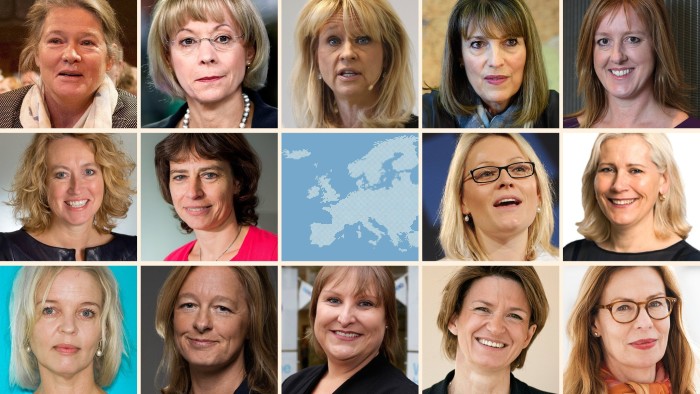All-male panels face backlash

Roula Khalaf, Editor of the FT, selects her favourite stories in this weekly newsletter.
After sitting on a series of all-male conference panels, Owen Barder started answering speaking invitations with more than a “yes” or “no”. “I got into the habit of writing back and saying: ‘Have you thought about inviting a woman instead?’” says Mr Barder, director of the Center for Global Development in Europe, a research group.
He is not alone in pointing out the predominance of conference panels consisting of men. Hundreds of posts submitted to a Tumblr social media account show photographs of all-male panels. Accompanying each post is the headline: “Congrats, you have an all-male panel!” along with an ironic depiction of masculinity in the form of actor David Hasselhoff giving a thumbs-up.
The dearth of women in public speaking reflects broader issues, from the lack of female chief executives to the predominance of men on corporate boards, particularly in industries such as technology, engineering, investing and financial services. “Historically men have dominated panels, and this isn’t surprising when you look at senior leadership in organisations and see mostly white men,” says Anna Beninger, research director at Catalyst, a non-profit body dedicated to promoting workplace diversity.
All-male panels are now prompting criticism that makes them a public relations liability for organisations running events. In Sweden, a campaign with the label #TackaNej (which translates roughly as “no thanks”) is attracting supporters, from media personalities to academics and entrepreneurs, who refuse to take part in conferences and panel discussions that have no female speakers.
GenderAvenger, a US-based campaign group, uses crowdsourcing to collect data on the gender balance of conference panels. Its app allows conference speakers and attendees to enter the gender balance of a panel, using the event’s hashtag and title. The app creates a pie chart showing the ratio of men to women, which can be posted instantly on Twitter or Facebook.
GenderAvenger has an online “Hall of Fame” and a “Hall of Shame” that uses Twitter hashtags to solicit information tracking how organisations are performing when it comes to the gender diversity of their events. “We are all about calling it out,” says Susan Askew, co-founder of the group.
Special Report

Pay fairly or watch top performers join your rivals
Many companies are struggling to retain mid-career women
‘Brutal advice’ has its reward
Leyla Boulton catches up with a finance professional and a chairman who were paired in a UK scheme
Online course helps women find sponsors
Aim is to help overlooked staff find senior advocates to diversify top ranks
Diversity needs skilled leaders
Mixed groups with conflicting views require more active and sensitive managers to run them
Close the gender gap to boost output
Narrowing the gender divide offers economic gains as well as societal benefits
Essay winner: Diversity benefits companies
Despite slow progress, women will exert their influence over the coming decade, writes Ivana Vasic Chalmers
A dearth of women speaking at events poses much more than a PR problem, say campaigners. “When you only have men on a panel, it suggests that women’s perspectives aren’t relevant — they literally don’t have a voice in these settings,” says Ms Beninger. “It also reinforces the perception that women don’t have the skills necessary to sit on a panel.”
In addition, all-male panels mean young women in the audience have no role models of their own gender to look to. One of the reasons this anomaly is attracting attention is that, while an absence of women at board meetings or in an office might pass unnoticed by those outside an organisation, panels are very public demonstrations of gender diversity — or the lack of it.
Experts however see dangers in selecting speakers on the basis of gender. “It’s really important that women are not there only to represent the viewpoint of women” but to serve as experts in their field, says Elisabeth Kelan, director of the Global Centre for Gender and Leadership at Cranfield School of Management.
Moreover, conference organisers who want to include women may not always find it easy to meet gender targets. “Since there are fewer women in senior positions in public life, it becomes that much harder to find a woman who is free and available,” says Mr Barder. The answer is “to be better organised and invite people sooner.”
Including women on teams that organise events appears to help. In a 2014 study, the American Society for Microbiology found that committees with at least one woman on them were less likely than teams composed entirely of men to come up with events consisting of all-male panels.
Resources are now available to help conference organisers find more female speakers. For example, Women in Research, a support group, has a database of market research experts, half of whom are women. One organisation has gone further: Great Women Speakers, based in Oregon, has a database comprising only female speakers.
BiasWatchNeuro, a website that tracks the speaker composition of conferences on neuroscience — a field in which women account for about a third of workers — draws attention to events where men make up the entire panel.
Some events organisers welcome the campaigns aimed at ending all-male panels. “The trend is positive,” says Leo von Bülow-Quirk, managing director for Europe at Chartwell, a global speakers agency. But he adds: “We still have a long way to go.”
Comments